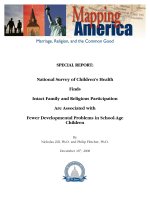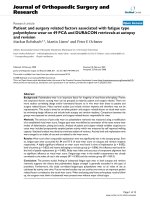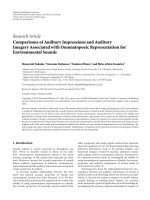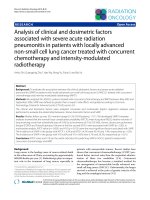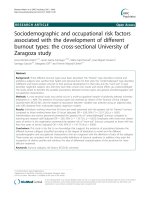Individual, family and environmental factors associated with pediatric excess weight in Spain: A cross-sectional study
Bạn đang xem bản rút gọn của tài liệu. Xem và tải ngay bản đầy đủ của tài liệu tại đây (274.36 KB, 8 trang )
Sánchez-Cruz et al. BMC Pediatrics 2014, 14:3
/>
RESEARCH ARTICLE
Open Access
Individual, family and environmental factors
associated with pediatric excess weight in Spain:
a cross-sectional study
José-Juan Sánchez-Cruz1*, Ingrid de Ruiter2 and José J Jiménez-Moleón2,3
Abstract
Background: There is a growing worldwide trend of obesity in children. Identifying the causes and modifiable
factors associated with child obesity is important in order to design effective public health strategies.
Our objective was to provide empirical evidence of the association that some individual and environmental factors
may have with child excess weight.
Method: A cross-sectional study was performed using multi-stage probability sampling of 978 Spanish children
aged between 8 and 17 years, with objectively measured height and weight, along with other individual, family
and neighborhood variables. Crude and adjusted odds ratios were calculated.
Results: In 2012, 4 in 10 children were either overweight or obese with a higher prevalence amongst males and in
the 8–12 year age group. Child obesity was associated negatively with the socio-economic status of the adult
responsible for the child’s diet, OR 0.78 (CI95% 0.59–1.00), girls OR 0.75 (CI95% 0.57–0.99), older age of the child
(0.41; CI95% 0.31–0.55), daily breakfast (OR 0.59; p = 0.028) and half an hour or more of physical activity every day.
No association was found for neighborhood variables relating to perceived neighborhood quality and safety.
Conclusion: This study identifies potential modifiable factors such as physical activity, daily breakfast and caregiver
education as areas for public health policies. To be successful, an intervention should take into account both individual
and family factors when designing prevention strategies to combat the worldwide epidemic of child excess weight.
Keywords: Overweight, Child, Adolescent, Risk factors, Physical activity, Breakfast
Background
The World Health Organization (WHO) defines obesity
as a disease, a complex condition with physical, social
and psychological dimensions, with serious health and
economic consequences [1].
In the U.S. the 2009–2010 prevalence of overweight
and obesity is 31.8% for children aged 2 to 19 years [2].
Europe estimates 20% of children and adolescence to
be overweight, with one third of these obese and the
annual rate of increase in this prevalence is growing
[3]. In Spain, the 2011 National Health Survey of
5495 children reported a combined prevalence of overweight and obesity of 29.1% in boys aged 2 to 17 years
* Correspondence:
1
Andalusian School of Public Health (EASP), Granada, Spain
Full list of author information is available at the end of the article
and 26.5% in girls of the same age; slightly higher than
previous National Health Survey outcomes [4].
Child obesity results in both immediate as well as
long term health consequences as risk profiles track
into adulthood [3,5,6]. These include social and psychological issues as well as orthopedic problems, type
2 diabetes, hypertension, sleep apnea, metabolic syndrome and lower quality of life [3,7-11]. Identifying
the causes and modifiable factors associated with
child obesity is important to be able to design effective public health strategies to reverse the current
obesity trends.
Multiple factors, including genetic, environmental,
cultural and socio-economic status may influence corporal weight [12-18]. Researchers of child and adolescent obesity have mainly focused on individual factors
such as gender, socio-economic position, physical
© 2014 Sánchez-Cruz et al.; licensee BioMed Central Ltd. This is an open access article distributed under the terms of the
Creative Commons Attribution License ( which permits unrestricted use,
distribution, and reproduction in any medium, provided the original work is properly cited.
Sánchez-Cruz et al. BMC Pediatrics 2014, 14:3
/>
activity, sedentary habits, nutrition and sleep duration
[12,13,19]. Evidence also suggests that environmental
and family factors influence adopted habits, particularly
in children [14-16,20,21]. The neighborhood environment can include both physical aspects, which create
opportunities or barriers for obesogenic behaviors, and
social aspects of perceived safety or facility availability
[22,23]. Additionally, in children and adolescents the
changing level of autonomy with age combined with
parental perception of neighborhood characteristics
may influence obesity related behaviors. Positive correlations between parent-reported neighborhood characteristics and child physical activity have been identified
in other studies [23]. Nonetheless, the use of environmental factors in children may be difficult due to the
ecological characteristics of this type of variable with
a high probability of misclassification bias, difficulty
to separate familial and environmental factors [15], as
well as constraints in establishing causal relationships
between environmental factors and child obesity. Scientific literature provides partial, incomplete, sometimes
contradictory and, therefore, inconclusive findings regarding the association of many of the individual and environmental factors on obesity. There is a need for new
research that combines these different types of factors,
in particular with the addition of family and environmental variables. This study aims to provide empirical
evidence of the association that some individual, family
and environmental factors may have on excess body
weight during childhood and adolescence.
Methods
Study design and population
A cross-sectional observational study was carried out
using probability sampling of the study population. The
study population consisted of children and adolescents, of
both sexes, between the ages of 8 and 17 years inclusive,
resident in family households in peninsular Spain. Data
were collected during April and May in 2012.
The probabilistic sample was based on a multistage clustered and stratified sample. Primary sampling units (municipalities) and secondary units (census groups) were
selected through a probability proportional to size (PPS)
method. Tertiary units (households) and individual units
were selected using a combination of random pathways
and quotas for sex and age. Population strata were formed
by the intersection of the 15 mainland regions with municipality population size divided into 5 categories: (1) less
than or equal to 2000 inhabitants; (2) 2001 to 10 000;
(3) 10 001 to 50 000; (4) 50 001 to 200 000; and (5) more
than 200 000 inhabitants. The selected sample was proportional to the size of the strata. The distribution of the two
age groups in the sample population (8–12 years and 13–
17 years) was equal to their proportions in the population.
Page 2 of 8
Measures and selected variables
Weight and height measurements were taken in the
presence of the adult responsible for the child’s diet,
who was also asked to complete socio-demographic
questions via computer-assisted personal interview, see
Additional file 1. Anthropometric measures of the different household members were measured using a scale
and height rod and followed a set measuring protocol.
The specific models used were: a) Scale – Tefal PP1027
A9, and b) Height rod: 5002.01.001 Soehnle professional.
The child was placed in the standing position, without
shoes, with hips and shoulders perpendicular to the central axis of the body, heels firmly planted on the ground,
knees close together and extended, relaxed arms, and
head in the Frankfurt plane. Body weight was determined through a digital anthropometric scale graded
from 0 to 150 kg with a resolution of 0.05 kg. The body
mass index (BMI) was calculated by the quotient of body
mass in kg by height in meters squared (m2), and subsequently overweight and obesity were defined according
to the World Health Organization criteria [24]. Excess
weight was defined as the presence of overweight or
obesity in the child or adolescent at the moment of
recruitment.
The questions and response scale used in the computerassisted personal interview are part of the standardized
questionnaire used in the Andalusian and National Health
surveys. The questionnaire used in our study was also initially tested on a sample of 50 people of the target
population.
The variables considered in this study, with their initial
categorization, were: a) age group of child: 8–12 years
(REF), 13–17 years; b) sex of child: male (REF), female;
c) population category of municipality: less than or equal
to 2000 inhabitants, 2001 to 10 000, 10 001 to 50 000,
50 001 to 200 000, and more than 200 000 inhabitants;
d) Education level of the adult responsible for the child’s
diet: Primary (REF), Secondary or University level studies; e) Employment status of the adult responsible for
the child’s diet: Employed, Unemployed but previously
employed, Looking for first employment, Retired (worked
previously), Housewife, Student, Disability, Permanent
Disability, Other; f ) Occupation of the adult responsible for the food of the children according to the national classification of occupations 2001 (CON-11); g)
Walking: less than 30 min per day (REF), 30 min or
more per day; h) Sleep duration: less than 9 hours per
night (REF), 9 hours or more per night; i) Variables related to dietary habits, including: daily breakfast, daily
freshly-squeezed orange juice, daily Yoghurt; j) TV
watching: watches TV every day, does not watch TV
every day; k) Perception of neighborhood quality:
Good/Very Good, Average/Poor/Very Poor (REF); l)
Perception of Neighborhood Safety: Good/Very Good
Sánchez-Cruz et al. BMC Pediatrics 2014, 14:3
/>
(REF), Average/Poor/Very Poor; m) Caregiver perception of Excess Weight: Excess weight is not detrimental
to health, Is detrimental but not as much as is alleged
by doctors or the media, Is detrimental for health.
Some variables were subsequently reclassified, as shown
in Table 1, due to the low number of observations in some
categories or due to similar behavior with respect to the
dependent variable. Maternal and paternal ages were
considered as continuous variables.
Data analyses
For descriptive statistics, the mean and standard deviation were calculated for continuous variables. For categorical variables, percentage distributions are shown.
Comparison of proportions was carried out using the
chi-squared statistic if its conditions were met, and if the
conditions were not met the Fisher exact test was used.
In order to jointly analyze the relationship of the considered independent variable with respect to excess
weight, a logistic regression model was applied. Possible
factors associated with excess weight were included in
this model and their odds ratios obtained. Maternal age
was considered as continuous when modeling the data,
as its relationship with the log of excess weight prevalence was approximately linear.
First, a logistic regression model of excess weight with
respect to the child’s sex and age was fitted. Next, a new
variable was added successively in each step (using the
forward method of introducing variables manually). The
variables selected to introduce into the models were
chosen according to epidemiological and statistical criteria. The effect of each exploratory variable in the
model and its significance was studied. If the variable
improved the model fit and adequacy (based on the likelihood ratio criteria and the significance of the parameter) it was kept for the next step; otherwise, the
variable was excluded. Different models were fitted with
respect to the factors related to the family and physical
environment. The model was checked for pair-wise
interaction between covariates. Interactions with the sex
and age of the child were considered. Potential confounding covariates were studied using a change of significance of the parameters in the model or a change of
30% of its value [25]. Once the model was fitted to the
data, the goodness of fit of the model was assessed by
the Hosmer-Lemeshow test. SPSS statistical package
version 18 was used to perform all analyses.
Ethics statement
Ethics approval was obtained from the Research and
Ethics Committee of the Andalusia School of Public Health
(Regional Ministry of Health, Regional Government of
Andalusia), with assurance of the anonymity of individual data in accordance with the requirements of Spanish
Page 3 of 8
law. Verbal consent was obtained from parents or legal
guardians as a pre-requisite to collecting information.
Consent procedure required an explanation of the research project, what it consisted of and the type of data
being collected.
Results
A total of 978 children were included in the analyses
and an overall participation rate of 80% was achieved.
The overall prevalence of overweight and obesity was
38.6% (CI95% 35.5 – 41.6%). Baseline characteristics of
the study population are shown in Table 1. The mean
age of the group was 12 years old (SD 2.94) and 50.2%
of the whole sample were male. The mother was the
adult responsible for the child’s diet in the majority of
cases (84.6%) and over 80% of the adults responsible for
diet perceived neighborhood safety and quality as either
good or very good. The majority (90%) of children ate
breakfast at least 5 days per week. Just over half of children exercised at least 30 minutes per day, and around
47% also watched television daily. With respect to sleeping hours, 41% slept less than 9 hours per day on
average.
The crude odds ratios are shown in Table 2 and the
adjusted odds ratios (OR) in Table 3. The statistically
significant associations found in the crude models held
in the adjusted model for age, sex, walking, and for the
child having daily breakfast. In both the crude and adjusted analyses the education level of the adult responsible for the child’s diet bordered on statistical significance
(p < 0.10). Regarding the child’s characteristics, females
were found to have a 25% lower risk of excess of weight
compared with males. We observed a higher risk of overweight and obesity in younger children (8–12 years)
compared with adolescents (13–17 years): the risk was
59% lower in this last group compared with children
aged 8–12, adjusted OR 0.41 (CI 95%, 0.31 – 0.55). A
lower risk was also found if the child walked at least
30 minutes per day, adjusted OR 0.73 (CI 95%, 0.56 –
0.96). Children that ate daily breakfast were observed
to be less likely to have excess weight, adjusted OR
0.59 (CI 95%, 0.36 – 0.94). With respect to the characteristics of the adult responsible for the child’s diet, we
found a trend towards a lower risk of excess weight
with a higher level of education of the adult responsible, adjusted OR 0.78 (CI 95%, 0.59-1.03). In our
study, variables related to the perceived environment
were not associated with youth excess weight in either
the crude or in the adjusted analyses, as can be seen in
Table 2.
Discussion
This study provides information on factors associated
with the prevalence of excess weight among children
Sánchez-Cruz et al. BMC Pediatrics 2014, 14:3
/>
Page 4 of 8
Table 1 Descriptive characteristics of survey population
n, mean (SD)1
Table 1 Descriptive characteristics of survey population
(Continued)
n (%)2
Caregiver perceptions of excess weight
Variables related to the child
Age
Sex
976, 11.99 (2.94)
Excess weight is not detrimental to health
11 (1.1)
19 (1.9)
945 (96.8)
8-12
534, 9.64 (1.38)
Is detrimental, but not as much as is said
by doctors or in the media
13-17
442, 14.82 (1.43)
Is detrimental for health
Male
490 (50.20)
Variables related to the environment
Female
486 (49.80)
Neighbourhood quality
Breakfast daily
4days or less per week
89 (9.1)
5 or more days per week
887 (90.9)
Less than 7 days per week
795 (81.7)
Average/Poor/Very Poor
178 (18.3)
Neighbourhood safety
Good/Very Good
819 (84.0)
105 (11.2)
Average
129 (13.2)
832 (88.8)
Poor/Very Poor
27 (2.8)
Freshly squeezed orange juice
7 days per week
Good/Very Good
1
n, mean (SD): Sample size, Mean (Standard Deviation).
2
n (%): Absolute frequency (Percentage).
Daily yoghurt
7 days per week
99 (10.6)
Less than 7 days per week
839 (89.4)
Watches TV everyday
459 (47.2)
Does not watch TV everyday
514 (52.8)
TV daily
Physical activity
< 30 min per day
527 (54)
30 min or more per day
446 (46)
Sleep duration
Less than 9 hrs/day
399 (40.9)
9 or more hrs/day
577 (59.1)
Variables related to the family
Maternal age
950, 40.76 (6.06)
Paternal age
798, 43.43 (6.19)
Adult responsible for child’s diet
Father
114 (11.7)
Mother
826 (84.6)
Others
36 (3.6)
Academic level of adult responsible for food
Primary
538 (57.2)
Secondary/University
402 (42.8)
Occupation of adult responsible for food
Manager/Professional
70 (11.8)
Unskilled worker/other
523 (88.2)
Employment status of adult responsible for food
Working
476 (52.2)
Unemployed
135 (14.8)
Housewife
301 (33.0)
and adolescents aged 8–17 in Spain. In 2012, approximately 4 out of every 10 children and adolescents were
overweight or obese with a higher prevalence amongst
males and those aged 8–12 years. Child obesity was also
shown to be associated with the sex of the child, the
education level of the adult responsible for the child’s
diet, the level of physical activity of the child as measured by time walking per day, and having breakfast
daily. For this reason, both individual and family factors
should be taken into account in the fight against the
worldwide epidemic of child excess weight.
Consistent with scientific literature in this area, our
findings show that the risk of excess weight is lower in
females than males. This result is consistent with observational studies in Europe, Japan and the USA [2,26-28].
As has been previously commented on in literature, differences in sexes could potentially be due to a variety of
influencing factors such as hormonal differences during
and post- puberty, cultural gender constructs or differing
influences of environmental or familial variables [29].
However, the association between sex and excess weight
persists in our study after adjusting for potential confounding factors related to individual, environmental
and familial variables. These differences could be explained by the role that non-modifiable variables, such
as genetic and hormonal factors, play in the weight of
a person.
In this study, older children were found to have a lower
risk of excess weight than younger children. This finding
could potentially be explained by an age-effect or could
indicate that the problem is getting worse over time and
will grow in the future if we do not act expediently [30].
The observed difference between age-groups close in time
is worrying and warrants further investigation.
Sánchez-Cruz et al. BMC Pediatrics 2014, 14:3
/>
Page 5 of 8
Table 2 Factors associated with excess weight in Spanish
youth aged 8-17
Table 3 Factors associated with excess weight in Spanish
youth aged 8–17 - Multivariate Analysis
Crude analysis
OR
95% CI
Adjusted analysis
p
Variables related
to the child
Sex
Physical Activity
Sleep duration
Breakfast daily
Male
1
Ref.
0.79
(0.61 – 1.02)
8-12 years
1
Ref.
13-17 years
0.86
(0.82 – 0.90)
<30 min/day
1
Ref.
≥30 min/day
0.73
(0.56 – 0.95)
<9 hrs/night
1
Ref.
≥9 hrs/night
1.06
(0.81 – 1.38)
Sex
Age
Physical activity
0.019
Breakfast daily
0.676
1
Ref.
1.47
(0.95 – 2.28)
0.083
Age of mother
Per year Increase
0.97
(0.96 – 0.98)
0.000
Age of father
Per year Increase
1.00
(0.99 – 1.00)
0.727
Level of education
of adult responsible
for food
Primary
1
Ref.
Secondary/University
0.77
(0.59 – 1.00)
Professional/ Manager
1
Ref.
Unskilled worker/other
0.54
(0.31 – 0.94)
1
Ref.
Unemployed
1.32
(0.87 – 2.01)
0.191
Employed
1.35
(1.00 – 1.82)
0.052
1
Ref.
Average
1.22
(0.84 – 1.78)
0.300
Poor or very poor
1.13
(0.52 – 2.46)
0.761
Very poor, poor or
average
1
Ref.
Good or very good
1.04
(0.74 – 1.45)
Obesity is bad for
health
1
Ref.
Obesity is not bad
for health
1.85
0.90, 3.83
0.051
0.028
Related to
neighbourhood
Perception of
neighbourhood
security
Perception of
neighbourhood
quality
Parental view on
child obesity
P
Good or very good
1
Ref.
0.75
(0.57 – 0.99)
8-12 years
1
Ref.
13-17 years
0.41
(0.31 – 0.55)
<30 min/day
1
Ref.
≥30 min/day
0.73
(0.56 – 0.96)
No
1
Ref.
Yes
0.59
(0.36 – 0.94)
1
Ref.
0.78
(0.59 – 1.03)
0.043
0.000
0.027
0.028
Related to the family
Related to the
family
Self-employed/
Housewife
Female
0.000
Yes
Employment status
of adult responsible
for food
Male
0.071
No
Occupation of adult
responsible for food
95% CI
Variables related to
the child
Female
Age
OR
0.836
0.099
Independently of the age and sex of the child, the role
that modifiable factors such as diet and physical activity
play in the obesity epidemic are clear and well established.
However, most interventions have focused mainly on the
Level of education of
adult responsible
for food
Primary
Secondary/
University
0.082
Variables in the crude analysis that were found to be not significant in the
multivariate analysis are not included in Table 3.
role of diet rather than on the role of physical activity. Not
having breakfast has been classically identified as a risk
factor for excess weight in childhood [17,31] and many interventions have been made to combat this factor and as
such, according to our results, the problem currently affects less than 10% of Spanish children. However, it seems
that so far physical activity has not been given the attention it deserves. Our findings show that children carrying
out physical activity on a regular basis are less prone to
suffer from excess weight than those with sedentary
habits, independent of sex or educational level of the adult
responsible for diet. Physical activity is considered an important factor in energy balance and a growing body of
evidence suggests that reduced daily physical activity is a
main cause of the worldwide increase in youth obesity and
overweight [1,32,33]. Physical activity should be promoted
as part of a healthy lifestyle to prevent excess weight gain
and this promotion should begin at an early age. However,
despite efforts being made, success is limited and variable
[34,35]. Perhaps a global and integrated approximation
to the problem is necessary, considering not only the
child but also the family and the environment where
the child lives.
The behavior of children depends largely on the family
environment in which they grow and we cannot analyze
a child’s diet and level of physical activity without considering the family environment. In this sense, a higher
level of parental education is less associated with overweight and obesity in the offspring and may be related
to differing lifestyle choices such as diet quality and act
Sánchez-Cruz et al. BMC Pediatrics 2014, 14:3
/>
in this way [17,31]. Although, considering the design
and information of our study, we were not able to
analyze these hypotheses. The IDEFICS consortium, based
on data from a cross-sectional baseline survey of a prospective cohort aged 2 to 9 years in eight European countries, shows that the intakes of vegetables, fruits, pasta/
noodles/rice, wholegrain bread and water increased as
educational level increased; while intakes of fried potatoes,
fried meat and fish, fast food, sugared beverages, snacks/
desserts and chocolate/nut-based spread increased as educational level decreased [17]. Further study is required to
clarify this relationship and investigate the underlying
mechanisms.
When the factors associated with child excess weight
are analyzed, we can clearly identify two types of factors:
a group of factors that depends directly on the child and
their behavior, and another group of factors related to
the family environment. The frontier between both
groups of factors is very difficult to establish, but if we
want to be successful in the control and prevention of
child excess weight we should consider both groups in
the design of adequate interventions. Perhaps family factors have not been playing the real role that they should
in child obesity prevention campaigns.
Along with individual and familial factors, we should
consider the role that environmental factors may play in
facilitating the adoption of healthy lifestyles. Certain environmental factors are widely considered as relevant for
the development and prevention of obesity, influencing
directly or indirectly the motivation of children to engage in physical activity. They may also influence diet
quantity and quality, due to the availability of opportunities
and places for the consumption of healthy or non-healthy
foods [18,22,36]. Our findings showed no association of
the measured environmental factors with excess weight in
youth. There are several reasons that should be taken into
account to explain these differences: 1) It is possible that
the environmental variables considered in our study were
measured in a subjective and perceived manner with a potential distortion from reality (if measured objectively).
This could create difficulty in finding statistically significant
differences compared with objective measures. For example, Bodor JN et al. described a high risk of obesity associated with fast food restaurants and convenience stores,
but had not considered neighborhood quality and safety
variables [36]; 2) Studies where they relate obesity to physical environmental factors usually work with adult population samples [22,36]; 3) The magnitude of the associations
found between obesity and environmental characteristics
are usually very weak, 1.01 (1.00 – 1.02) for fast food restaurants and obesity in Bodor’s study [36]; and 4) Alternatively, environmental factors could indirectly influence
obesity-related behavior through individual and familial
variables, which can be very important in children [23].
Page 6 of 8
Whatever the reason is for why environmental factors were
not significant in this study is beyond the scope of this
research.
As potential limitation of our study we should cite: 1)
Its observational nature and the weakness associated
with any cross-sectional study in that no temporal relationship or direction of association can be determined.
One obvious drawback in this type of epidemiologic
study is possible reverse causation or common upstream
cause. Cross-sectional associations may reflect the combined intervention of the true effects of a particular factor as well as artificial effects due to reverse causation
and confounding by other variables. The absence of association found between variables related to diet and
weight in our study could be explained by this and it
can’t be forgotten that diet is one of the first things that
people modify when wanting to lose weight; 2) Another
limitation to be considered is the subjective nature of interviewees’ perceptions of their neighborhood and level
of physical activity, as previously discussed. However, we
can also consider that the perception of neighborhood
security may be more important in level of physical activity than objective neighborhood security; 3) We should
also keep in mind that marginal social classes are not included in health surveys. In addition, children who belong
to the lower (but non marginal) social classes enjoy great
protection due to the public policies of the Spanish welfare state, and this can attenuate the observed associations
between socio-economic status and excess weight. As advantages of our study we should highlight that: 1) Our
sample is representative of Spanish children 8–17 years.
The multi-stage probability sampling method used resulted in a sample that was representative of the target
population, meaning that the results can be extrapolated
to a greater population; 2) While many studies use subjective measures for child weight, this study used objective
measures for weight, height and BMI outcomes; 3) We
tried to integrate the role of individual and social factors
on the risk of excess of weight in children, unlike other
studies that are based on only individual variables; 4)
Missing data were minimal and were not different from
data of the included participants.
Conclusions
The results in this paper provide relevant information to
be considered when developing public health policies,
professional care in the area of childhood overweight
and obesity and further research. In our study we identify as areas for public health policies and further research potentially modifiable factors such as physical
activity and caregiver education. If we want to be successful, an adequate intervention for the control of the
obesity epidemic in children should not forget to act on
both the child and his social context.
Sánchez-Cruz et al. BMC Pediatrics 2014, 14:3
/>
Additional file
Additional file 1: File name: cuestionario obesidad infantil BMC
Pediatrics.pdf. File type: Acrobat file. Title of dataset: Estudio sobre
obesidad infantil y juvenil. Description: Questionnaire used in this study
to collect socio-demographic information on study participants.
Competing interests
The authors declare no conflict of interests.
Authors’ contributions
JJSC is the main researcher of the project number PI10/02018, he
participated in the design of the study and statistical analysis of the data and
the discussion of the results. IdR has collaborated in the analysis, discussion
of the results and preparation of the initial draft. JJJM contributed to the
analysis and discussion of the results. All authors were involved in writing
the finished paper and had final approval of the submitted and published
versions.
Acknowledgements
This study was funded by grant number PI10/02018, Ministerio de Economía
y Competitividad del Reino de España (Ministry of Economy and
Competitiveness, Spain), Instituto de Salud Carlos III-FEDER.
Author details
1
Andalusian School of Public Health (EASP), Granada, Spain. 2Department of
Preventive Medicine and Public Health, University of Granada, Granada,
Spain. 3CIBER of Epidemiology and Public Health (CIBERESP), Granada, Spain.
Received: 13 June 2013 Accepted: 1 January 2014
Published: 8 January 2014
References
1. World Health Organization (WHO): Obesity: Preventing and managing the
global epidemic. Report of a WHO consultation: WHO Technical Report Series,
No. 894. 894th edition. Geneva: WHO; 2000.
2. Ogden CL, Carroll MD, Kit BK, Flegal KM: Prevalence of obesity and trends
in body mass index among US children and adolescents, 1999–2010.
JAMA 2012, 307:483–490.
3. World Health Organization: The challenge of obesity in the WHO European
Region and the strategies for response. Copenhagen: World Health
Organization Europe; 2007.
4. Spanish Ministry of Health and Social Policies: Spanish National Health
Survey 2011/2012. Spain: MSPS; 2013.
5. Van Stralen MM, Te Velde SJ, Van NF, Brug J, Grammatikaki E, Maes L, De BI,
Verbestel V, Galcheva S, Iotova V, Koletzko BV, Von KR, Bayer O, Kulaga Z,
Serra-Majem L, Sanchez-Villegas A, Ribas-Barba L, Manios Y, Chinapaw MJ:
Weight status of European preschool children and associations with
family demographics and energy balance-related behaviours:
a pooled analysis of six European studies. Obes Rev 2012, 13(1):29–41.
6. Singh AS, Mulder C, Twisk JW, Van MW, Chinapaw MJ: Tracking of
childhood overweight into adulthood: a systematic review of the
literature. Obes Rev 2008, 9:474–488.
7. Lobstein T, Baur L, Uauy R: Obesity in children and young people:
a crisis in public health. Obes Rev 2004, 5(Suppl 1):4–104.
8. Steinberger J, Daniels SR, Eckel RH, Hayman L, Lustig RH, McCrindle B,
Mietus-Snyder ML: Progress and challenges in metabolic syndrome in
children and adolescents: a scientific statement from the American Heart
Association Atherosclerosis, Hypertension, and Obesity in the Young
Committee of the Council on Cardiovascular Disease in the Young;
Council on Cardiovascular Nursing; and Council on Nutrition, Physical
Activity, and Metabolism. Circulation 2009, 119:628–647.
9. Weiss R, Dziura J, Burgert TS, Tamborlane WV, Taksali SE, Yeckel CW, Allen K,
Lopes M, Savoye M, Morrison J, Sherwin RS, Caprio S: Obesity and the
metabolic syndrome in children and adolescents. N Engl J Med 2004,
350:2362–2374.
10. Wille N, Erhart M, Petersen C, Ravens-Sieberer U: The impact of overweight
and obesity on health-related quality of life in childhood–results from an
intervention study. BMC Public Health 2008, 8:421.
Page 7 of 8
11. Williams J, Wake M, Hesketh K, Maher E, Waters E: Health-related quality of
life of overweight and obese children. JAMA 2005, 293:70–76.
12. Rey-Lopez JP, Vicente-Rodriguez G, Biosca M, Moreno LA: Sedentary behaviour
and obesity development in children and adolescents. Nutr Metab Cardiovasc
Dis 2008, 18:242–251.
13. Haug E, Rasmussen M, Samdal O, Iannotti R, Kelly C, Borraccino A,
Vereecken C, Melkevik O, Lazzeri G, Giacchi M, Ercan O, Due P,
Ravens-Sieberer U, Currie C, Morgan A, Ahluwalia N: Overweight in
school-aged children and its relationship with demographic and
lifestyle factors: results from the WHO-Collaborative Health Behaviour
in School-aged Children (HBSC) study. Int J Public Health 2009,
54(Suppl 2):167–179.
14. Van der Horst K, Oenema A, Ferreira I, Wendel-Vos W, Giskes K, Van LF,
Brug J: A systematic review of environmental correlates of obesityrelated dietary behaviors in youth. Health Educ Res 2007, 22:203–226.
15. Bolivar J, Daponte A, Rodriguez M, Sanchez JJ: The influence of
individual, social and physical environment factors on physical
activity in the adult population in Andalusia, Spain. Int J Environ Res
Public Health 2010, 7:60–77.
16. Franzini L, Elliott MN, Cuccaro P, Schuster M, Gilliland MJ, Grunbaum JA,
Franklin F, Tortolero SR: Influences of physical and social neighborhood
environments on children’s physical activity and obesity. Am J Public
Health 2009, 99:271–278.
17. Fernandez-Alvira JM, Mouratidou T, Bammann K, Hebestreit A, Barba G,
Sieri S, Reisch L, Eiben G, Hadjigeorgiou C, Kovacs E, Huybrechts I,
Moreno LA: Parental education and frequency of food consumption in
European children: the IDEFICS study. Public Health Nutr 2013, 16:487–498.
18. Puhl RM, Heuer CA: The stigma of obesity: a review and update. Obesity
(Silver Spring) 2009, 17:941–964.
19. Singh GK, Siahpush M, Kogan MD: Rising social inequalities in US
childhood obesity, 2003–2007. Ann Epidemiol 2010, 20:40–52.
20. Nelson MC, Gordon-Larsen P, Song Y, Popkin BM: Built and social
environments associations with adolescent overweight and activity. Am J
Prev Med 2006, 31:109–117.
21. Feng J, Glass TA, Curriero FC, Stewart WF, Schwartz BS: The built
environment and obesity: a systematic review of the epidemiologic
evidence. Health Place 2010, 16:175–190.
22. Bodor JN, Rose D, Farley TA, Swalm C, Scott SK: Neighbourhood fruit and
vegetable availability and consumption: the role of small food stores in
an urban environment. Public Health Nutr 2008, 11:413–420.
23. Tappe KA, Glanz K, Sallis JF, Zhou C, Saelens BE: Children’s physical activity
and parents’ perception of the neighborhood environment:
neighborhood impact on kids study. Int J Behav Nutr Phys Act 2013, 10:39.
24. World Health Organization (WHO): The WHO Child Growth Standards. Spain:
WHO; 2013.
25. Miettinen OS, Cook EF: Confounding: essence and detection. Am J
Epidemiol 1981, 114:593–603.
26. Kouda K, Nakamura H, Nishio N, Fujita Y, Takeuchi H, Iki M: Trends in body
mass index, blood pressure, and serum lipids in Japanese children: Iwata
population-based annual screening (1993–2008). J Epidemiol 2010,
20:212–218.
27. Meigen C, Keller A, Gausche R, Kromeyer-Hauschild K, Bluher S, Kiess W,
Keller E: Secular trends in body mass index in German children and
adolescents: a cross-sectional data analysis via CrescNet between
1999 and 2006. Metabolism 2008, 57:934–939.
28. Sjoberg A, Lissner L, Albertsson-Wikland K, Marild S: Recent anthropometric
trends among Swedish school children: evidence for decreasing prevalence
of overweight in girls. Acta Paediatr 2008, 97:118–123.
29. Rodriguez MA, Novalbos Ruiz JP, Villagran PS, Martinez Nieto JM, Lechuga
Campoy JL: Parents perception of childhood overweight and obesity and
eating behaviors, physical activity and sedentary lifestyle of their
children. Spain. Rev Esp Salud Publica 2012, 86:483–494.
30. Sanchez-Cruz JJ, Jimenez-Moleon JJ, Fernandez-Quesada F, Sanchez MJ:
Prevalence of Child and Youth Obesity in Spain in 2012. Rev Esp Cardiol
2013, 66:371–376.
31. Tandon PS, Zhou C, Sallis JF, Cain KL, Frank LD, Saelens BE: Home
environment relationships with children’s physical activity, sedentary
time, and screen time by socioeconomic status. Int J Behav Nutr Phys Act
2012, 9:88.
32. Wang Y, Lobstein T: Worldwide trends in childhood overweight and
obesity. Int J Pediatr Obes 2006, 1:11–25.
Sánchez-Cruz et al. BMC Pediatrics 2014, 14:3
/>
Page 8 of 8
33. Timperio A, Salmon J, Telford A, Crawford D: Perceptions of local
neighbourhood environments and their relationship to childhood
overweight and obesity. Int J Obes (Lond) 2005, 29:170–175.
34. Waters E, De Silva-Sanigorski A, Hall BJ, Brown T, Campbell KJ, Gao Y,
Armstrong R, Prosser L, Summerbell CD: Interventions for preventing
obesity in children. Cochrane Database Syst Rev 2011, 12:CD001871.
35. Trinh A, Campbell M, Ukoumunne OC, Gerner B, Wake M: Physical Activity
and 3-Year BMI Change in Overweight and Obese Children. Pediatrics
2013, 131:e470–e477.
36. Bodor JN, Rice JC, Farley TA, Swalm CM, Rose D: The association between
obesity and urban food environments. J Urban Health 2010, 87:771–781.
doi:10.1186/1471-2431-14-3
Cite this article as: Sánchez-Cruz et al.: Individual, family and
environmental factors associated with pediatric excess weight in Spain:
a cross-sectional study. BMC Pediatrics 2014 14:3.
Submit your next manuscript to BioMed Central
and take full advantage of:
• Convenient online submission
• Thorough peer review
• No space constraints or color figure charges
• Immediate publication on acceptance
• Inclusion in PubMed, CAS, Scopus and Google Scholar
• Research which is freely available for redistribution
Submit your manuscript at
www.biomedcentral.com/submit

